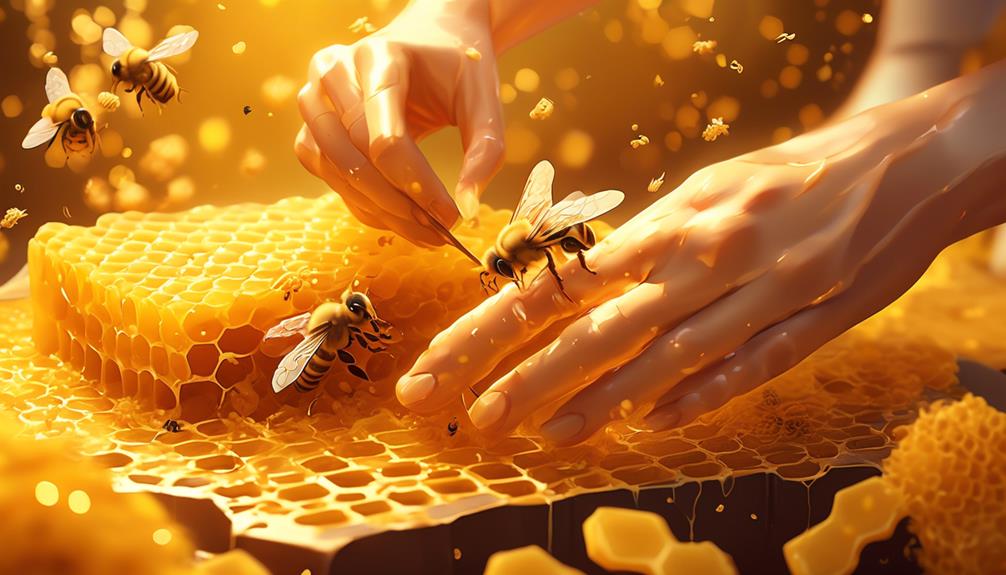An exploration into using beeswax for skin, revealing its myriad benefits, application methods, and potential drawbacks; is it your skincare routine's missing puzzle piece?

How to Use Beeswax for Skin?
Is it true that beeswax could be your skin's new best friend? You've likely heard the buzz about beeswax as a natural, beneficial addition to skincare routines, but let's explore the facts.
Beeswax, derived directly from our industrious honeybee friends, is touted to have numerous skin benefits, ranging from moisturizing to healing effects. But how do you actually use beeswax for your skin, and what are the potential pros and cons?
As we navigate this topic together, you'll uncover the secrets behind this lesser-known skincare ingredient, and whether or not it's the right fit for your skin's unique needs.
Key Takeaways
- Beeswax is a natural moisturizer that seals in hydration and prevents dryness.
- It is a rich source of Vitamin A, promoting skin regeneration and smoothness.
- Beeswax forms a protective barrier on the skin without clogging pores.
- It possesses antibacterial and anti-inflammatory properties, making it beneficial for soothing irritated skin and keeping it clear of blemishes.
Understanding the Benefits of Beeswax

Delving into the benefits of beeswax, you'll find that it boasts a range of properties that can significantly enhance your skin health and overall complexion.
Primarily, beeswax acts as a natural moisturizer, sealing in your skin's natural hydration and thwarting dryness. It's also a rich source of Vitamin A which encourages skin regeneration and smoothness.
Moreover, beeswax forms a protective barrier on your skin, without clogging pores. This barrier helps safeguard your skin from environmental contaminants and harsh weather conditions. Additionally, it has anti-inflammatory properties that can soothe irritated skin, making it an ideal ingredient for those with sensitive skin or conditions like eczema and rosacea.
The antibacterial properties of beeswax shouldn't be overlooked either. They help keep your skin clear of blemishes and acne. Finally, beeswax aids in skin softening and elasticity, contributing to a youthful and healthy appearance.
Understanding these benefits, you'll see why incorporating beeswax into your skincare routine can be a game-changer. It's more than just a buzzword in the beauty industry; it's a potent, natural ingredient that can help you achieve the radiant skin you've always wanted.
Sourcing Quality Beeswax for Skin

Now that you're acquainted with the numerous benefits of beeswax for skin, let's explore how to source top-notch quality beeswax to ensure you're reaping all these advantages.
First, it's crucial to know that beeswax comes in various forms, such as blocks, pellets, and bars. Regardless of the form, always prioritize organic, unprocessed beeswax. This ensures it's free from harmful pesticides and chemicals that can negate the skin benefits of beeswax.
Next, consider the color. High-quality beeswax typically ranges from a bright yellow to a deep golden hue. If it's too light or dark, it may have been processed or adulterated.
Lastly, check for a subtle, honey-like aroma. This indicates that the beeswax is fresh and of high quality.
Purchase from reputable suppliers or local beekeepers to guarantee the product's authenticity. Always read reviews and do your research before making a purchase.
Preparing Your Beeswax for Use

Once you've sourced your high-quality beeswax, it's important to prepare it properly to maximize its benefits for your skin. Start by cleaning your beeswax. If it's in a block, you'll need to grate it into smaller pieces. This makes it easier to melt and combine with other ingredients. Be careful during this process as beeswax is quite hard and you don't want to injure yourself.
Next, you'll need to melt the beeswax. This is best done using a double boiler to avoid overheating, which can destroy its beneficial properties. Place the beeswax in the top part of the double boiler and fill the bottom part with water. Heat the water over medium heat until the beeswax melts completely.
Then, once melted, you can combine the beeswax with other skin-nourishing ingredients like essential oils or carrier oils. Be sure to stir thoroughly to make sure everything is well combined.
Beeswax Applications for Different Skin Types

After you've melted and combined the beeswax with other ingredients, it's crucial to understand how to apply this mixture for different skin types to reap maximum benefits.
For dry skin, beeswax acts as an emollient and a humectant, drawing moisture to the skin and sealing it in. You can make a rich moisturizer by mixing beeswax with oils like avocado or jojoba. Apply this before bed, and you'll wake up to well-hydrated skin.
If you've oily skin, beeswax can help balance your skin's oil production. A lightweight lotion made from beeswax, witch hazel, and a light carrier oil like grapeseed won't leave your skin feeling greasy.
Sensitive skin types can also benefit from beeswax, as it creates a protective barrier on the skin surface. Combine beeswax with soothing ingredients like chamomile or aloe to reduce inflammation and redness.
For mature skin, beeswax is a boon. Its ability to retain moisture and its rich vitamin A content promote cell regeneration and soften skin. A beeswax-based night cream with rosehip or argan oil can combat wrinkles effectively.
Remember to patch test any new product you create to ensure your skin reacts positively.
Combining Beeswax With Other Ingredients

In the realm of skincare, combining beeswax with other ingredients enhances its effectiveness, allowing you to tailor your homemade products to suit your specific skin type and needs. It's important to know which ingredients work best with beeswax to unlock its full potential.
For dry skin, consider blending beeswax with olive oil or shea butter. Both are rich in moisturizing properties, creating a hydrating concoction that nourishes parched skin.
If you're battling acne, pair beeswax with tea tree oil. Its antibacterial properties can help keep breakouts at bay.
Combining beeswax with coconut oil can result in a moisturizing lip balm, perfect for chapped lips.
For those with sensitive skin, beeswax and aloe vera can be a soothing duo. Aloe vera is known for its calming effects and can help reduce skin irritation.
Lastly, if you're aiming for an anti-aging formula, beeswax and vitamin E oil can be your go-to. Vitamin E is a powerful antioxidant, helping to combat the effects of free radicals on your skin.
Maintaining Skin Health With Beeswax

Your skin's health can significantly benefit from the regular use of beeswax, thanks to its myriad of natural properties that nourish, protect, and heal. It's rich in vitamin A, which promotes cell regeneration and skin health. Also, its anti-inflammatory properties help to soothe irritated skin, making it ideal for those with sensitive skin or conditions such as eczema.
Incorporating beeswax into your skincare routine is a breeze. You can find it in various forms, from lotions, creams to lip balms. Daily application can help you maintain a healthy, glowing complexion.
Here's a breakdown of how beeswax can benefit your skin:
Properties of Beeswax | Benefits for Skin |
|---|---|
Rich in Vitamin A | Promotes cell regeneration and skin health |
Anti-inflammatory | Soothes irritated skin, suitable for eczema |
Moisturizing | Hydrates skin, prevents dryness and flaking |
Frequently Asked Questions
Can Beeswax Cause Allergic Reactions on the Skin?
Yes, beeswax can cause allergic reactions on your skin. Though it's generally considered safe for most people, you may be allergic to it if you're allergic to honey or other bee products. Signs of an allergic reaction include redness, swelling, itching, or discomfort at the application site. If you notice these symptoms, stop using the product immediately and consult a healthcare provider.
Always patch test new products before full application.
How Long Does It Take to See Results When Using Beeswax for Skin?
You're wondering how long it takes to see results from using beeswax on your skin.
Well, it's not an overnight miracle. You'll typically start noticing improvements in your skin's texture and hydration levels in about two weeks.
However, it's important to remember that everyone's skin is unique, so results can vary.
Keep using it consistently and you'll likely see the benefits over time.
Can Beeswax Be Used on Sensitive Areas Such as the Face and Lips?
Yes, you can use beeswax on sensitive areas like your face and lips. It's known for its moisturizing and healing properties, making it suitable for these areas.
However, always do a patch test before applying it extensively. If you're allergic to honey or pollen, you might've a reaction, but generally, it's safe.
It's often found in lip balms and facial creams, proving its efficacy and gentleness on sensitive skin.
Is It Safe to Use Beeswax on Skin During Pregnancy or Breastfeeding?
Yes, it's generally safe to use beeswax on your skin during pregnancy or breastfeeding. Beeswax is a natural product that doesn't typically cause irritation. However, everyone's body reacts differently, especially during pregnancy. It's always best to patch test a small area first.
If you notice redness, swelling or discomfort, stop using it immediately. Always consult your healthcare provider if you're unsure about using any new products during pregnancy or while breastfeeding.
Can Beeswax Be Used for Skin Conditions Like Eczema or Psoriasis?
Yes, you can use beeswax for skin conditions like eczema or psoriasis. It's known for its soothing and healing properties. It forms a protective barrier on the skin, locking in moisture and reducing dryness and flaking.
Furthermore, it's packed with vitamin A which promotes skin regeneration. However, always do a patch test first, as you'd want to ensure you're not allergic to it.
It's best to consult with a healthcare professional before starting any new treatment.
Conclusion
In conclusion, beeswax is a versatile skincare marvel. Sourcing quality beeswax and preparing it properly ensures optimal benefits.
Adapting its use to your skin type and combining it with other beneficial ingredients can boost its effectiveness. With proper use, beeswax can be a key component in maintaining your skin's health.
Start your journey with beeswax today and unlock its full potential for your skincare routine.


